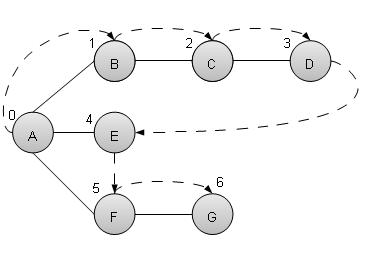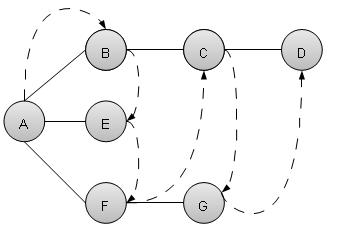
- DSA using C - Home
- DSA using C - Overview
- DSA using C - Environment
- DSA using C - Algorithms
- DSA using C - Concepts
- DSA using C - Array
- DSA using C - Linked List
- DSA using C - Doubly Linked List
- DSA using C - Circular Linked List
- DSA using C - Stack
- DSA using C - Parsing Expressions
- DSA using C - Queue
- DSA using C - Priority Queue
- DSA using C - Tree
- DSA using C - Hash Table
- DSA using C - Heap
- DSA using C - Graph
- DSA using C - Search techniques
- DSA using C - Sorting techniques
- DSA using C - Recursion
- DSA using C Useful Resources
- DSA using C - Quick Guide
- DSA using C - Useful Resources
- DSA using C - Discussion
DSA using C - Graph
Overview
Graph is a datastructure to model the mathematical graphs. It consists of a set of connected pairs called edges of vertices. We can represent a graph using an array of vertices and a two dimentional array of edges.
Important terms
Vertex − Each node of the graph is represented as a vertex. In example given below, labeled circle represents vertices. So A to G are vertices. We can represent them using an array as shown in image below. Here A can be identified by index 0. B can be identified using index 1 and so on.
Edge − Edge represents a path between two vertices or a line between two vertices. In example given below, lines from A to B, B to C and so on represents edges. We can use a two dimentional array to represent array as shown in image below. Here AB can be represented as 1 at row 0, column 1, BC as 1 at row 1, column 2 and so on, keeping other combinations as 0.
Adjacency − Two node or vertices are adjacent if they are connected to each other through an edge. In example given below, B is adjacent to A, C is adjacent to B and so on.
Path − Path represents a sequence of edges between two vertices. In example given below, ABCD represents a path from A to D.

Basic Operations
Following are basic primary operations of a Graph which are following.
Add Vertex − add a vertex to a graph.
Add Edge − add an edge between two vertices of a graph.
Display Vertex − display a vertex of a graph.
Add Vertex Operation
//add vertex to the vertex list void addVertex(char label){ struct vertex* vertex = (struct vertex*) malloc(sizeof(struct vertex)); vertex->label = label; vertex->visited = false; lstVertices[vertexCount++] = vertex; }
Add Edge Operation
//add edge to edge array void addEdge(int start,int end){ adjMatrix[start][end] = 1; adjMatrix[end][start] = 1; }
Display Edge Operation
//display the vertex void displayVertex(int vertexIndex){ printf("%c ",lstVertices[vertexIndex]->label); }
Traversal Algorithms
Following are important traversal algorithms on a Graph.
Depth First Search − traverses a graph in depthwards motion.
Breadth First Search − traverses a graph in breadthwards motion.
Depth First Search Algorithm
Depth First Search algorithm(DFS) traverses a graph in a depthward motion and uses a stack to remember to get the next vertex to start a search when a dead end occurs in any iteration.

As in example given above, DFS algorithm traverses from A to B to C to D first then to E, then to F and lastly to G. It employs following rules.
Rule 1 − Visit adjacent unvisited vertex. Mark it visited. Display it. Push it in a stack.
Rule 2 − If no adjacent vertex found, pop up a vertex from stack. (It will pop up all the vertices from the stack which do not have adjacent vertices.)
Rule 3 − Repeat Rule 1 and Rule 2 until stack is empty.
void depthFirstSearch(){ int i; //mark first node as visited lstVertices[0]->visited = true; //display the vertex displayVertex(0); //push vertex index in stack push(0); while(!isStackEmpty()){ //get the unvisited vertex of vertex which is at top of the stack int unvisitedVertex = getAdjUnvisitedVertex(peek()); //no adjacent vertex found if(unvisitedVertex == -1){ pop(); } else { lstVertices[unvisitedVertex]->visited = true; displayVertex(unvisitedVertex); push(unvisitedVertex); } } //stack is empty, search is complete, reset the visited flag for(i=0;i < vertexCount;i++){ lstVertices[i]->visited = false; } }
Breadth First Search Algorithm
Breadth First Search algorithm(BFS) traverses a graph in a breadthwards motion and uses a queue to remember to get the next vertex to start a search when a dead end occurs in any iteration.

As in example given above, BFS algorithm traverses from A to B to E to F first then to C and G lastly to D. It employs following rules.
Rule 1 − Visit adjacent unvisited vertex. Mark it visited. Display it. Insert it in a queue.
Rule 2 − If no adjacent vertex found, remove the first vertex from queue.
Rule 3 − Repeat Rule 1 and Rule 2 until queue is empty.
void breadthFirstSearch(){ int i; //mark first node as visited lstVertices[0]->visited = true; //display the vertex displayVertex(0); //insert vertex index in queue insert(0); int unvisitedVertex; while(!isQueueEmpty()){ //get the unvisited vertex of vertex which is at front of the queue int tempVertex = removeData(); //no adjacent vertex found while((unvisitedVertex=getAdjUnvisitedVertex(tempVertex)) != -1){ lstVertices[unvisitedVertex]->visited = true; displayVertex(unvisitedVertex); insert(unvisitedVertex); } } //queue is empty, search is complete, reset the visited flag for(i=0;i<vertexCount;i++){ lstVertices[i]->visited = false; } }
Example
#include <stdio.h> #include <string.h> #include <stdlib.h> #include <stdbool.h> #define MAX 10 struct Vertex { char label; bool visited; }; //stack variables int stack[MAX]; int top=-1; //queue variables int queue[MAX]; int rear=-1; int front=0; int queueItemCount = 0; //graph variables //array of vertices struct Vertex* lstVertices[MAX]; //adjacency matrix int adjMatrix[MAX][MAX]; //vertex count int vertexCount = 0; //stack functions void push(int item) { stack[++top]=item; } int pop() { return stack[top--]; } int peek() { return stack[top]; } bool isStackEmpty(){ return top == -1; } //queue functions void insert(int data){ queue[++rear] = data; queueItemCount++; } int removeData(){ queueItemCount--; return queue[front++]; } bool isQueueEmpty(){ return queueItemCount == 0; } //graph functions //add vertex to the vertex list void addVertex(char label){ struct Vertex* vertex = (struct Vertex*) malloc(sizeof(struct Vertex)); vertex->label = label; vertex->visited = false; lstVertices[vertexCount++] = vertex; } //add edge to edge array void addEdge(int start,int end){ adjMatrix[start][end] = 1; adjMatrix[end][start] = 1; } //display the vertex void displayVertex(int vertexIndex){ printf("%c ",lstVertices[vertexIndex]->label); } //get the adjacent unvisited vertex int getAdjUnvisitedVertex(int vertexIndex){ int i; for(i=0; i<vertexCount; i++) if(adjMatrix[vertexIndex][i]==1 && lstVertices[i]->visited==false) return i; return -1; } void depthFirstSearch(){ int i; //mark first node as visited lstVertices[0]->visited = true; //display the vertex displayVertex(0); //push vertex index in stack push(0); while(!isStackEmpty()){ //get the unvisited vertex of vertex which is at top of the stack int unvisitedVertex = getAdjUnvisitedVertex(peek()); //no adjacent vertex found if(unvisitedVertex == -1){ pop(); } else { lstVertices[unvisitedVertex]->visited = true; displayVertex(unvisitedVertex); push(unvisitedVertex); } } //stack is empty, search is complete, reset the visited flag for(i=0;i < vertexCount;i++){ lstVertices[i]->visited = false; } } void breadthFirstSearch(){ int i; //mark first node as visited lstVertices[0]->visited = true; //display the vertex displayVertex(0); //insert vertex index in queue insert(0); int unvisitedVertex; while(!isQueueEmpty()){ //get the unvisited vertex of vertex which is at front of the queue int tempVertex = removeData(); //no adjacent vertex found while((unvisitedVertex=getAdjUnvisitedVertex(tempVertex)) != -1){ lstVertices[unvisitedVertex]->visited = true; displayVertex(unvisitedVertex); insert(unvisitedVertex); } } //queue is empty, search is complete, reset the visited flag for(i=0;i<vertexCount;i++){ lstVertices[i]->visited = false; } } main() { int i, j; for(i=0; i<MAX; i++) // set adjacency for(j=0; j<MAX; j++) // matrix to 0 adjMatrix[i][j] = 0; addVertex('A'); //0 addVertex('B'); //1 addVertex('C'); //2 addVertex('D'); //3 addVertex('E'); //4 addVertex('F'); //5 addVertex('G'); //6 /* 1 2 3 * 0 |--B--C--D * A--| * | * | 4 * |-----E * | 5 6 * | |--F--G * |--| */ addEdge(0, 1); //AB addEdge(1, 2); //BC addEdge(2, 3); //CD addEdge(0, 4); //AC addEdge(0, 5); //AF addEdge(5, 6); //FG printf("Depth First Search: "); //A B C D E F G depthFirstSearch(); printf("\nBreadth First Search: "); //A B E F C G D breadthFirstSearch(); }
If we compile and run the above program then it would produce following result −
Depth First Search: A B C D E F G Breadth First Search: A B E F C G D